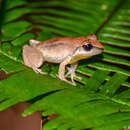Description
provided by AmphibiaWeb articles
Eleutherodactylus auriculatus is a tiny frog, with adult males measuring up to 20 mm and females to 24 mm in SVL. Digital discs are developed. There is no webbing between the toes. The vomerine teeth, behind the choanae, are present in an oblique series (Cope 1862; Bogart 1981; Ruiz 1987; Schwartz and Henderson 1985; Schwartz and Henderson 1991). This frog is dark brown to tan or light gray, with the sides darker than the dorsum. A dark bar runs across the back and above the insertion of the forelimbs. Some individuals have a median dorsal light stripe. A brown to black line descends from the upper orbit to near the shoulder, crossing the upper part of the tympanum. The loreal region is black. A blackish band extends between the eyes. The hind limbs are dark with the concealed surfaces brownish in color. The venter is vivid yellow; the vocal sac is greenish with black dots (Cope 1862; Bogart 1981; Ruiz 1987; Schwartz and Henderson 1985; Schwartz and Henderson 1991).Eleutherodactylus auriculatus is a member of the subgenus Eleutherodactylus) (Heinicke et al., 2007)[3930]. Synonyms include Hylodes auriculatus and Eleutherodactylus sonans (Cope 1862; Dunn 1925). The chromosome number is 18 (Bogart 1981).
- Bogart, J. P. (1981). ''Chromosome studies in Sminthillus from Cuba and Eleutherodactylus from Cuba and Puerto Rico (Anura: Leptodactylidae).'' Life Science Contribution, Royal Ontario Museum, 129, 1-22.
- Cope, E. D. (1862). ''On some new and little known American anura.'' Proceedings of the Academy of Natural Sciences of Philadelphia, 14, 151-159.
- Drewes, R. C., and Wilkinson, J. A. (2004). ''The California Academy of Sciences Gulf of Guinea Expedition (2001) I. The taxonomic status of the genus Nesionixalus Perret, 1976 (Anura: Hyperoliidae): treefrogs of São Tomé and Príncipe, with comments on the genus Hyperolius.'' Proceedings of the California Academy of Sciences, 55, 395-407.
- Estrada, A. R., and Hedges, S.B. (1997). ''A new species of frog from the Sierra Maestra, Cuba (Leptodactylidae, Eleutherodactylus).'' Journal of Herpetology, 31(3), 364-368.
- Hedges, S. B. and Díaz, L. M. (2004). Eleutherodactylus auriculatus. In: IUCN 2007. 2007 IUCN Red List of Threatened Species. http://www.iucnredlist.org/. Downloaded on 10 November 2007.
- Hedges, S.B., Estrada, A.R., and Thomas, R. (1992). ''Three new species of Eleutherodactylus from eastern Cuba, with notes on vocalizations of other species (Anura: Leptodactylidae).'' Herpetological Monographs, 6, 68-83.
- Schwartz, A. (1969). ''The Antillean Eleutherodactylus of the auriculatus group.'' Studies of the Fauna of Curacao and other Caribbean Islands, 114, 99-115.
Distribution and Habitat
provided by AmphibiaWeb articles
This species is endemic to Cuba and Isla de la Juventud. It is found island-wide, from sea level to about 1400 m, occurring in forests (Schwartz and Henderson 1991).
Life History, Abundance, Activity, and Special Behaviors
provided by AmphibiaWeb articles
Adult frogs are active throughout the day, although more activity is common at night (Fong unpublished). Males vocalize from shrubs, tree trunks and branches, vines, leaves, dead stumps and sometimes from the ground (Schwartz and Henderson 1991; Fong unpublished). Calls are similar to a flat telegraphic clicking, often with a few warm-up clicks, and composed of one note repeated continuously in close regular intervals (229-276 calls/minute). The dominant frequency is about 3.8-3.9 kHz (Schwartz 1969; Schwartz and Henderson 1991; Hedges et al. 1992; Estrada and Hedges 1997). This frog is a direct developing species. Clutches consist of about 20 eggs, and are deposited in bromeliads or on the ground (Schwartz and Henderson 1991).
Life History, Abundance, Activity, and Special Behaviors
provided by AmphibiaWeb articles
Clear-cutting of the forest, agriculture, infrastructure development for tourism and human settlement and disturbance of the forest by tourists are the main threats to this species (Hedges and Diaz 2004). Some natural areas in eastern Cuba have been degraded and substituted by coffee plantations, timber forests and pastures, causing the extirpation of this species from its original habitat (Fong 1999).
Eleutherodactylus auriculatus
provided by wikipedia EN
Eleutherodactylus auriculatus is a species of frog in the family Eleutherodactylidae endemic to Cuba. It is a widespread species that also occurs on the Isla de Juventud. It is found from sea level to 1,300 m (4,300 ft) asl.[2]
Eleutherodactylus auriculatus is a very common, arboreal species. Its natural habitats are mesic primary and secondary forests. It can also occur in coffee plantations with tall trees grown for shade. The eggs are laid in bromeliads or on the ground. It is threatened by habitat loss caused by clear-cutting, agriculture, and infrastructure development.[1]
References

- license
- cc-by-sa-3.0
- copyright
- Wikipedia authors and editors
Eleutherodactylus auriculatus: Brief Summary
provided by wikipedia EN
Eleutherodactylus auriculatus is a species of frog in the family Eleutherodactylidae endemic to Cuba. It is a widespread species that also occurs on the Isla de Juventud. It is found from sea level to 1,300 m (4,300 ft) asl.
Eleutherodactylus auriculatus is a very common, arboreal species. Its natural habitats are mesic primary and secondary forests. It can also occur in coffee plantations with tall trees grown for shade. The eggs are laid in bromeliads or on the ground. It is threatened by habitat loss caused by clear-cutting, agriculture, and infrastructure development.
- license
- cc-by-sa-3.0
- copyright
- Wikipedia authors and editors

